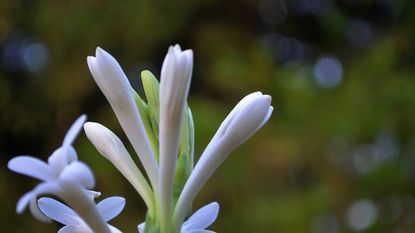The History Of Tuberose Flowers


The tuberose is a flower that has long been cultivated and used in decorations and religious ceremonies. Although not as fashionable as it once was, the intense fragrance of this bloom and its delicate, pretty flowers are making it more popular once again. Check out the long, partly lost, and fascinating history of tuberose plants here.
Tuberose Flower History
Tuberose is Polianthes tuberosa, a species of flower related to agave. It is thought to be native to Mexico, but no one really knows for sure. Today, tuberose is a cultivated plant no longer found in the wild. It's origins and early history remain a mystery.
The tuberose plant grows with a long, thin, and straight stem up to 3 feet tall (1 m.). At the top of the stem is a cluster of small, white flowers sometimes tinged with pink. These are surrounded by grass like leaves. The sweet, floral smell of the blooms is intense.
Europeans first discovered tuberose when the Spanish conquistadors landed in the New World. The Aztecs, Mayans, and other native groups had already been growing the plant. The Aztecs called it bone flower for the white color of the blooms. The tuberose was recorded in Europe by the early 1600's.
In Europe, tuberoses became especially popular in the Victorian era of England. The flower was prized for its fragrance and was used in funerals. It's possible that the association with death led to a decline in popularity of tuberose. Too bad since they're really beautiful and smell so nice.
Tuberose Uses Through Time
Throughout history, tuberose plants have been noted for their fragrance. They also make great cut flowers. These are the two main uses and reasons for growing tuberoses, both in the past and today.
For hundreds of years, perfumes have been made using tuberose. The flowers were also important in Hawaiian wedding ceremonies and funerals in Victorian England. Today, these once ubiquitous flowers are making a comeback. Grow them in warm climates or in containers in cooler climates. Use them for cut flowers or just to enjoy the fragrance, which intensifies even more at night.
Gardening tips, videos, info and more delivered right to your inbox!
Sign up for the Gardening Know How newsletter today and receive a free download of our most popular eBook "How to Grow Delicious Tomatoes."

Mary Ellen Ellis has been gardening for over 20 years. With degrees in Chemistry and Biology, Mary Ellen's specialties are flowers, native plants, and herbs.
-
 Want a Backyard Mini Orchard? Create Your Own Container Orchard
Want a Backyard Mini Orchard? Create Your Own Container OrchardEasier to care for in small spaces, a backyard mini-orchard makes sense for busy gardeners and juicy fruit is the reward.
By Teo Spengler
-
 Urban Beekeeping Guide: Top Tips For Raising Bees In The City
Urban Beekeeping Guide: Top Tips For Raising Bees In The CityUrban beekeeping can be a rewarding and appreciated pastime, but first be sure it’s legal in your city and learn the ropes of beekeeping.
By Mary Ellen Ellis